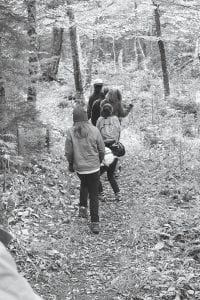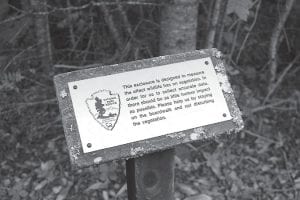As part of the ongoing studies of interaction between wolves, moose and vegetation on Isle Royale, the National Park Service has created an “exclosure” near Windigo Harbor. The exclosure keeps moose out so researchers can compare this moose-free zone with the rest of the island, which is possibly being over-browsed by the large herbivores in the absence of a healthy wolf population. Left: A park ranger leads a group of Girl Scouts through the exclosure. Inset: The sign designating the exclosure area.

With only two wolves left on Isle Royale, the National Park Service has signaled that it is at least thinking about introducing more wolves back onto the island. A mid-March report follows public comments and internal deliberations regarding wolf/moose/vegetation management on the Lake Superior island.
The National Park Service’s wolf/moose/vegetative environmental impact statement (EIS) looks at four alternatives.
Alternative A would mean no action by the National Park Service (NPS).
Alternative B allows NPS to bring wolves to the island as a one-time event over a defined period of time (e.g. over a 36-month period) to increase the longevity of the wolf population on the island.
Alternative C would allow NPS to bring wolves to the island as needed.
Alternative D would allow the natural process to continue and allow NPS to continue current management practices. Certain indicators or thresholds would be developed under Alternative D that if met, would trigger the reintroduction of wolves to the island as a one-time event. A trigger here could be over browsing of vegetation on the island by moose.
While the wolf population has declined from a high of about 50 in 1980 to two in 2016, the moose population has steadily risen to about 1,500 in 2016.
Last year the Park Service introduced a moose/wolf/ vegetative management plan and solicited public comment. The plan, now revised, looks at how to manage the moose and wolf populations over the next 20 years.
“The potential absence of wolves raises concerns about possible effects of Isle Royale’s current ecosystem, including effects to both the moose population and Isle Royale’s forest/vegetation communities,” states the March 13 EIS.
“Given the revised scope of the EIS, actions to manage moose, such as culling or translocation of moose, as well as actions to manage vegetation, such as fire, direct restoration, or other tools, will not be considered in this EIS. After a decision is made regarding whether and how to bring wolves to Isle Royale, the NPS will monitor conditions on the island, and will initiate additional planning processes to address other aspects of the island ecosystem, such as moose population and forest community, if such a planning processes are deemed necessary.”
With no other predators to keep their numbers in check, researchers worry that moose are starting to over browse areas on the island, damaging the vegetation. In the winter moose like to eat balsam fir, but that is a species that is declining on the island because of global warming. As food dwindles, researchers also worry that moose will suffer from starvation.
Wolves nearly disappeared from the island in the 1980s after canine parvovirus was introduced to the island by a dog. Numbers continued to decline because of inbreeding and disease. Wolves first came (in modern times) to the island in the 1940s on ice bridges from Canada. In 2013 one wolf left the island via an ice bridge, and in 2014 two wolves visited from the mainland but then returned.
While some insist that the NPS not interfere with the natural order of things, for Isle Royale that is already too late. In 1951-52 four pen-raised wolves were brought to the island from the Detroit Zoo and released.
While the EIS states, “The future presence of wolves on the island is in doubt unless new wolves emigrate or are introduced,” there are no plans to speed up the process. The Park Service said it does not expect to have a final plan until the summer of 2017, which is 2½ years after the study began.
Two Michigan Tech professors, John Vucetich and Rolf Peterson (now retired) have spent much of their careers studying the predator/prey relationship between the moose and wolves on the island, keeping a Michigan Tech study going that began in 1958. This is the longest predator/prey study conducted anywhere. If wolves disappear from the island, the study will end.
The NPS will hold one more 60-day public comment period later this spring. Comments can be submitted at https://parkplanning.nps.gov/commentForm.cfm?documentID=71605.



Loading Comments